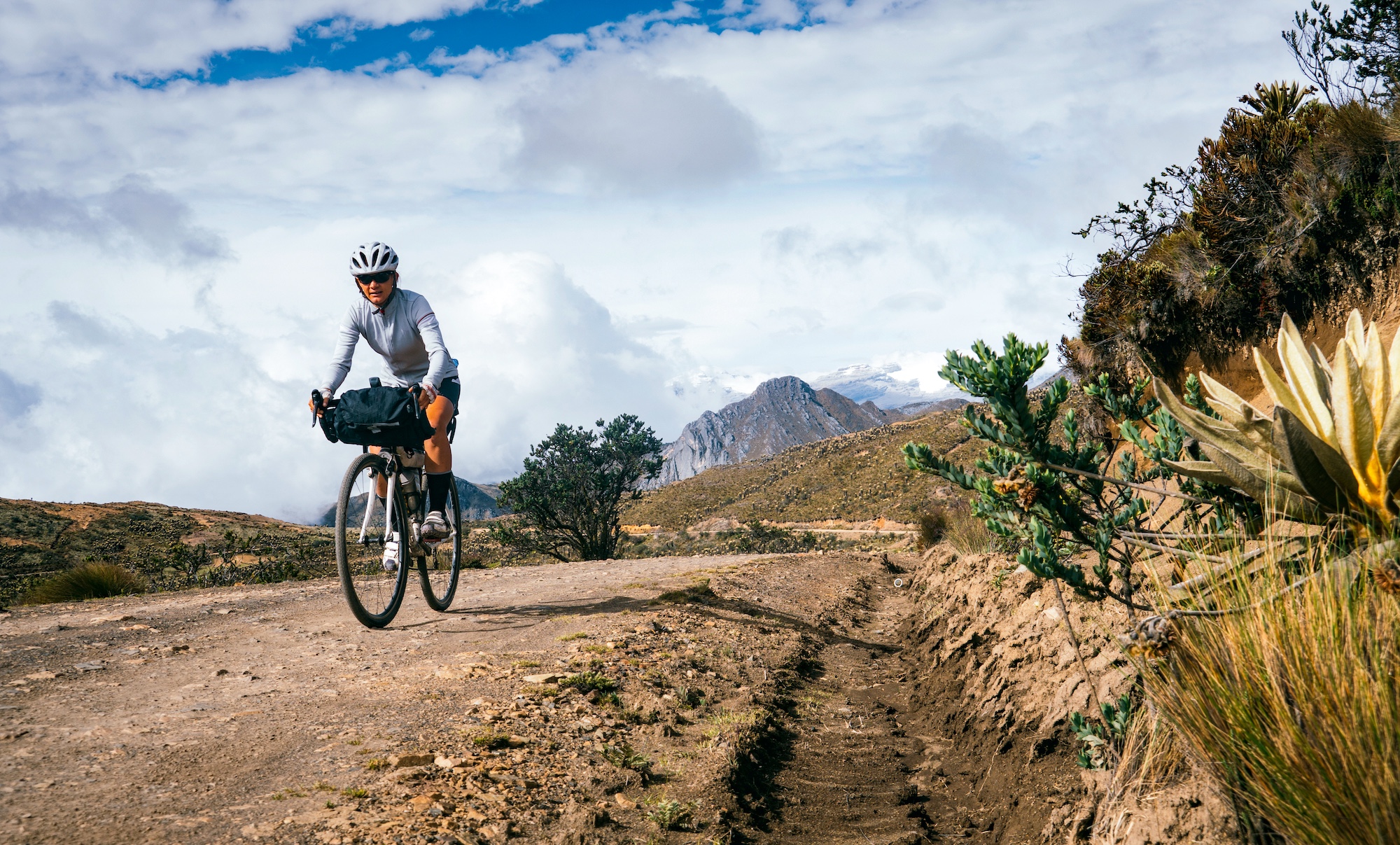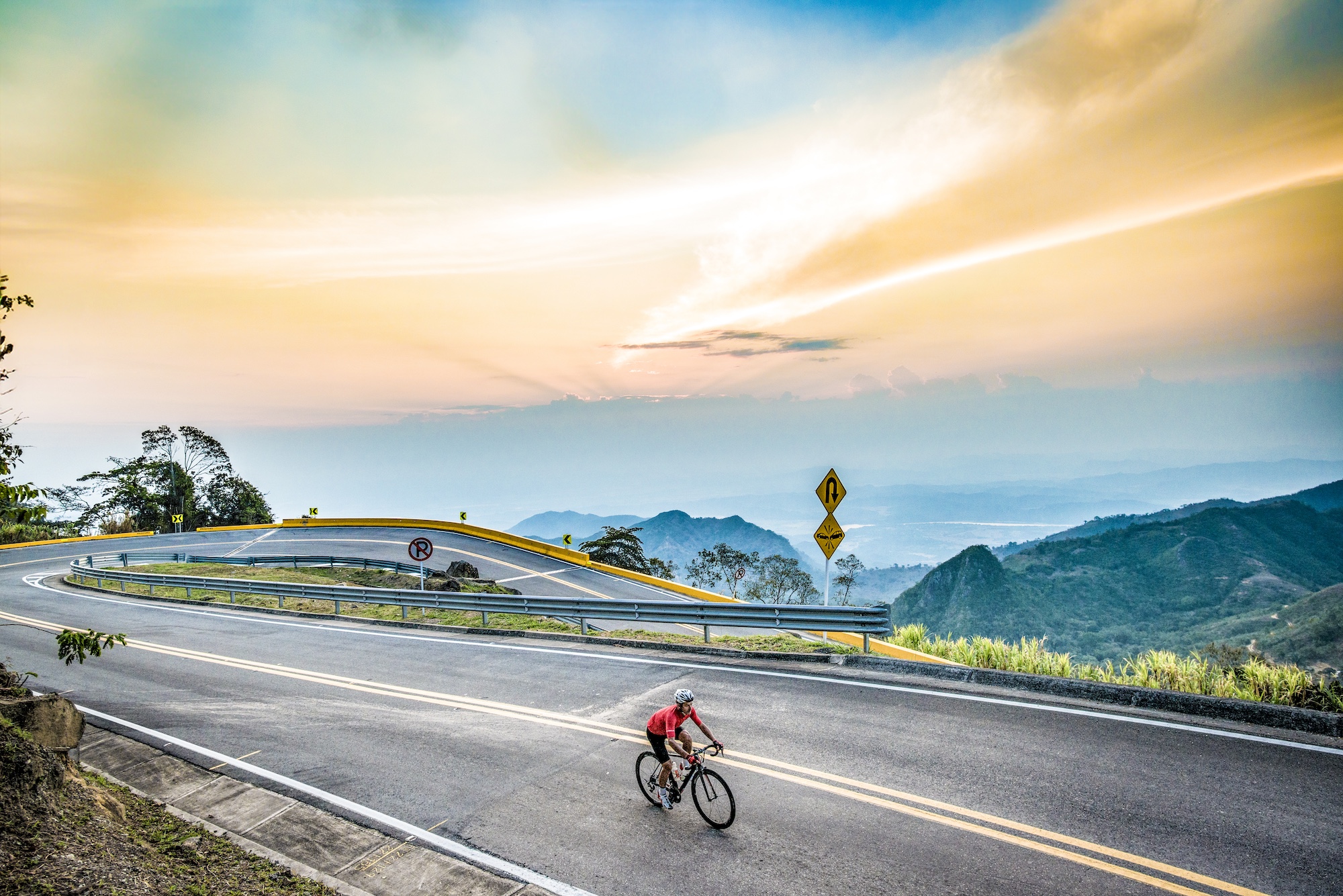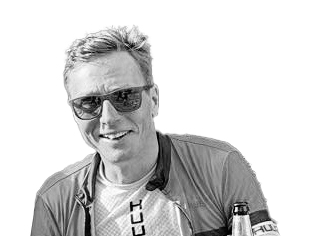In Colombia, cyclists aren't a nuisance, they're part of the national story
Often maligned as unsafe, Colombia is a superb, if far flung cycling destination. And it comes with plenty of climbs... Big climbs


"Is it safe?" and "What was it like going up Alto de Letras?" Those are the two questions I'm asked whenever I mention that I spent a chunk of February this year cycling in Colombia. The first question comes from non-cyclists, the second from riders who know their climbs - usually with a glint in their eye.
They know that Letras is the stuff of legend: 80km uphill, rising from steaming valleys to the thin air of a 3,680m pass. It was lined up for day three of our 10-day tour across the Andes - but I knew there was going to be so much more to this amazing country than one massive climb.
The seed for the trip was planted during a tour in the Alps last summer, when our Saddle Skedaddle guide told me that Colombia was his favourite place to ride. He'd done nine tours from Bogotá to Cartagena via Medellín, and spoke about lush mountain scenery, soaring climbs and wall-to-wall sunshine. Back home in the Lake District, flicking through the itinerary of the trip, and weighing it up against another grey February in Cumbria, the choice was easily made: I booked immediately.
Bogotá breath training
Our group was a mix of riders from the UK, US, Australia and New Zealand. All were very experienced riders curious about tackling terrain beyond Europe's familiar climbs like Mont Ventoux or the Galibier. We quickly discovered that in Colombia, cyclists aren't a nuisance - we're part of the national story. That sense of being welcome underpinned the whole trip.
Our start location was Bogotá, which sits at 2,640m above sea level. The tour operator suggested arriving early to acclimatise to the thin air. It was sage advice. On my first day, I set out to hike up Mount Monserrate (3,152m) assuming that, fit from my winter training, I'd be fine. Instead, I found myself gasping for breath as locals of all ages and sizes breezed past. A preview of what was to come.
On Sundays, Bogotá closes more than 120km of roads to cars, turning them over to cyclists, runners and families - known as the weekly Ciclovia. We were not there to join in, unfortunately, but a couple of us managed a short ride the day before our tour proper started. This included the main climb out of Bogotá as well as a visit to Egan Bernal's shop. We were to learn that Colombians have a deep respect for their cycling stars - not only Tour de France champion Bernal, but Rigoberto Urán, Nairo Quintana and riders from previous eras such as Luis 'Lucho' Herrera and Martin 'Cochise' Rodríquez.
Our short shake-out ride had helped settle our nerves, but nothing could have prepared us for dropping from the high plateau into Colombia's deep valleys. The tour proper began after a short transfer out of the capital to avoid the worst of the traffic. With the busy streets behind us, we set out through rolling country, which remained the theme of the next two days: terrain lumpy enough to keep the effort honest at all times.
The latest race content, interviews, features, reviews and expert buying guides, direct to your inbox!
Passing through Colombian towns was endlessly distracting: the noise, the music, the roadside cafes, motorbikes buzzing past, colourful lorries with burnished chrome, and children waving and shouting encouragement.

By day three, we were in Mariquita, 495m above sea level. The Letras ascent would take us up to 3,680m in one continuous climb. The stats are intimidating: over 80km of uphill and 4,100m of climbing - making it one of the longest road climbs in the world. It begins, unsurprisingly, in the heat. As we hit the lower slopes, it began to pour with rain - and didn't cease for the next 40km. With the temperature at 34°C, the downpour was more relief than hindrance, lending the climb a lush, tropical feel as rain dripped from the roadside banana leaves.
The initial gradients were 'grippy', averaging 7% for the first 5km. It's not the steepness but the sheer scale of the mountain that plays tricks with your head. Half an hour in, we had barely dented it. Hours later, we were still going. The average gradient of 4% is skewed by five mid-climb descents; the true average of the uphill is closer to 6%. As we rose, the landscape transformed. Jungle gave way to farmland - still plenty of trees, but interspersed with open pasture.
Beyond halfway, as the air thinned, so did the tree cover, replaced by rocky crags, while the road stretched endlessly upwards ahead of us. Clouds skimmed across the tarmac, and it was now getting cold. The group spread out into ones and twos. Support vans leapfrogged us, our Colombian drivers emerging with fresh fruit, water, energy bars and bocadillos-guava paste blocks that became our fuelling saviour.
The stalls selling fresh fruit and drinks, commonplace on the lower slopes, were now far behind us. Trucks ground past, always patient to give us plenty of space. I found myself in a rhythm, counting off the kilometre markers on my head-unit, trying not to contemplate the number still to go.
"The Andes had far more in store for us"
Chris Fellows
Hours blurred into each other. Anxiety about the possible effects of the high altitude affected us all, though thankfully no one succumbed to any serious sickness. That said, none of us were immune to the effects of reduced oxygen, and it became steadily harder to suck enough air into our lungs to sustain our complaining quadriceps. Over the final 20km, my breathing and heart rates were noticeably higher, and my speed considerably lower.
Reaching the pass wasn't about a burst of glory - more relief, disbelief and quiet satisfaction. Seven hours for some, less for others, but everyone who got to the top was proud to do so (the Strava KOM is an incredible 3:01:53 by Colombian Didier Chaparro). Standing there in the cool mountain air, with the world spread out below, we remembered that this was just day three. The Andes had far more in store for us.

Treasures and treachery
What followed were days of climbing and descending, up one valley wall and down the next. The climbs weren't as long as Letras, but many were steeper, and all came at altitude. Occasional rain swept in without warning, soaking us in minutes, then the sun returned as if nothing had happened.
The road surfaces were generally good but never predictable: speed humps of almost infinite variety and ingenuity, some of them very vicious, would appear like an ambush at the bottom of descents, while drains lurked at the edge. Roadworks came upon you suddenly, providing scant warning before the road deteriorated into a quagmire. On some descents, there were treacherous patches of tarmac with undulations redolent of a fairground ride. But traffic was generally light, and drivers consistently courteous. Compared to the UK, it felt like another world.
The length of the descents was truly breathtaking - some of them seemed neverending. On the busier roads, this meant overtaking multiple lorries - not something I'd consider doing in the UK, but made possible in Colombia in part by the polite nature of the drivers, who would often signal to let you know when to overtake.
"Vultures circled above as we drank in a cafe, later to be seen stripping the flesh off hides pegged out by farmers alongside the road"
Chris Fellows
Wildlife kept surprising us: vultures circling above as we drank in a cafe, later to be seen stripping the flesh off hides pegged out by farmers alongside the road. Hummingbirds darted around hotel gardens, colourful macaws flashed majestically over the jungle vegetation - and we even saw wild pigs swimming in the lowland wetlands.
Towns offered strong coffee, plates of rice and beans, grilled chicken or steak for a few pounds. Simple, filling, perfect for tired legs.
It was easy to make connections in the group; we bonded through the rhythm of the riding: long climbs tackled at our own pace, descents shared with wide grins, evenings spent swapping stories over cold beer - until the tiredness overwhelmed us.

Much Maligned Medellin
Famous for all the wrong reasons, Medellin was the mid-point of our tour and provided the setting for a rest day. It is beyond the scope of this feature to describe what the cities of Colombia have to offer; suffice to say that Medellin has a vast array of fascinating sights and sounds.
My particular favourite was a tour up into District 13, one of the favelas that the cities in South America are infamous for. After days spent in the countryside, this was a complete contrast. Loud music of every genre assaulted our ears from every direction, street art painted every building in vibrant colours, and the sublime smells of the street food filled the air.
Hordes of people on foot competed for space with moped riders forced to a crawl as we were guided towards one of the highest spots overlooking the city. The guide explained how the favelas had been transformed by escalators and cable cars, enabling residents to access work in the city below, with a concomitant reduction in crime. Not once did we feel threatened or in any danger.
"In Colombia, cyclists are heroes, drivers respect you, children wave from doorways, and cafe owners ask about your route."
Chris Fellows
The final days brought a dramatic change. A 30-mile descent took us from the mountains into the heat of the lowlands. Humidity replaced cool mountain air as the green valleys gave way to wetlands and flat plains. On our final stretch to Cartagena on the Caribbean coast, roadside rubbish heaps were a dramatic contrast to the pristine hills we had been cycling through for days before.
Arriving in Cartagena after 10 days of riding, the city's colourful colonial streets felt surreal. Tourists thronged the plazas, music spilled from open doors, the sea shimmered in the background. Finally it was time to relax and reflect on our trip.

So why should a cyclist choose Colombia? For me, three things stood out. The riding itself: incomparable climbs, varied landscapes, a mix of challenge and exhilaration. Second, the culture: in Colombia, cyclists are heroes, drivers respect you, children wave from doorways, and cafe owners ask about your route. Lastly, the sense of adventure: weather, altitude, unpredictability - but always rewarded by views, food and friendship.
Be warned, though, cycling in Colombia isn't easy. The climbs are long, the altitude tests everyone, and the days are demanding. But that's exactly what makes it unforgettable. For me, Colombia wasn't just a cycling holiday. It was the trip of a lifetime.
Key Information for riding in Colombia
How to get there: Direct flights from London to Bogotá take around 11 hours and cost anywhere between £600 and £1,200 return, plus £75-£100 each way for a bike box. Transfers from Bogotá airport are straightforward. We flew with Iberia from Manchester via Madrid.
When to go: The best time for cycling in Colombia is December through February, and July to August, which are the drier periods. Temperatures are fairly constant throughout the year, though it is of course cooler at altitude.
Where to stay: Hotels ranged from very basic to modern city stays. Expect £40-£80 per night if booking independently. All welcomed cyclists, with safe bike storage.
Organised tours: We travelled with Saddle Skedaddle. Their 13- day Colombian tour costs from £3,995 including accommodation, most meals, guides, support vehicles and transfers (flights not included). Two Colombian drivers provided daily support, handing out water, fruit and energy bars.
Eating and drinking: Meals are hearty and affordable: grilled meat or chicken with rice, beans, plantain and salad for £7-£12. Fruit is abundant - pineapple, mango, guava, papaya - and bocadillos (guava paste) are a cyclist's favourite. Coffee is available everywhere but can be rough-and-ready outside the big cities.
What we rode: Chris took his own bike, a 2014 Pinarello Dogma 65.1 with Campagnolo Super Record groupset, 50/34 chainset and 11-28t cassette - for him, this provided a plentiful spread of gears for the climbs. Colombian terrain can be unforgiving, wet and muddy, so if you're worried about ruining your pride and joy,

Chris Fellows is a semi- retired veterinary surgeon turned globe-trotting adventure cyclist
You must confirm your public display name before commenting
Please logout and then login again, you will then be prompted to enter your display name.